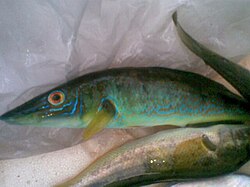| Blue weed whiting | |
|---|---|
 | |
| Scientific classification | |
| Kingdom: | Animalia |
| Phylum: | Chordata |
| Class: | Actinopterygii |
| Order: | Labriformes |
| Family: | Labridae |
| Subfamily: | Hypsigenyinae |
| Genus: | Haletta Whitley, 1947 |
| Species: | H. semifasciata |
| Binomial name | |
| Haletta semifasciata (Valenciennes, 1840) | |
| Synonyms [2] | |
| |
The blue weed whiting (Haletta semifasciata) is a species of ray-finned fish, a weed whiting from the family Labridae, [3] which is endemic to Australia where it is only found along the southern coast. It is found in brackish and marine waters in sheltered locations at depths of from 1 to 7 metres (3.3 to 23.0 ft). This species inhabits areas with a substrate of sand with beds of seagrass where it feeds on small invertebrates and algae and the seagrasses themselves. This species grows to a length of 29 centimetres (11 in) SL. It is of minor importance to local commercial fisheries. This species is the only known member of its genus. [2]




